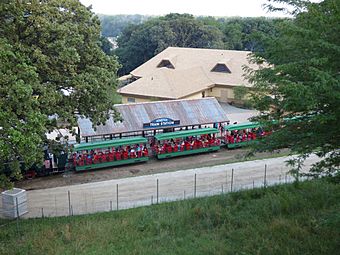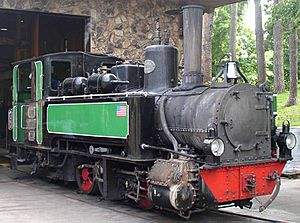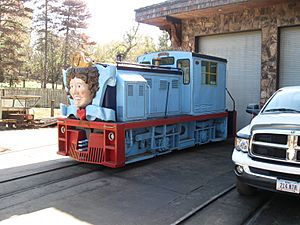Omaha Zoo Railroad facts for kids

Kenefick Train Station
|
|
| Overview | |
|---|---|
| Headquarters | Omaha, Nebraska |
| Reporting mark | OZRR |
| Locale | Henry Doorly Zoo & Aquarium in Omaha, Nebraska |
| Dates of operation | 1968–present |
| Technical | |
| Track gauge | 2 ft 6 in (762 mm) |
| Length | 1.8 miles |
The Omaha Zoo Railroad (or OZRR) is a special train ride at the Henry Doorly Zoo & Aquarium in Omaha, Nebraska. It's a "narrow-gauge" railway, which means its tracks are narrower than regular train tracks. This fun train takes zoo visitors on an exciting trip around the park, often pulled by a steam locomotive. You can hop on at two different stations inside the zoo. More than 200,000 people ride the Omaha Zoo Railroad every year!
Contents
History of the Zoo Railroad
The Omaha Zoo Railroad was one of the first big attractions added to the zoo after it became the Henry Doorly Zoo in 1963. The Union Pacific Railroad, a large train company based in Omaha, helped build the zoo's train ride. This was part of their 100-year celebration.
Building the Tracks
The zoo's railroad first had about 2 miles (3.2 km) of narrow-gauge track. This track was roughly half the width of normal train tracks. The tracks were laid out like a twisted oval with a path connecting the middle.
Train crews from Union Pacific helped lay the tracks. The train started running on July 22, 1968. Robert Kovar, a Union Pacific expert, oversaw the project.
Early Days and Union Pacific Theme
The Omaha Zoo Railroad was designed to look like Union Pacific's famous First Transcontinental Railroad. Omaha was the starting point for that historic line. Passengers would get on at the "Omaha train depot." They would ride to "Promontory Junction" at the south end of the zoo's lagoon.
The ride also included a climb up "Sherman Hill." This was named after a real steep hill on the Union Pacific line in Wyoming. The zoo's steam locomotive looked like Union Pacific's No. 119. This famous engine was used when the "Golden spike" was laid, finishing the transcontinental line.
The zoo railroad's logo even had a Union Pacific shield with a smiling tiger! Union Pacific has continued to support the zoo's railroad over the years. In 1994, the Union Pacific Engine House was built at the zoo. This building helps maintain the trains.
Growing the Railroad
In the 1970s, more and more people visited the zoo and rode the train. The original four-car train wasn't big enough. So, the zoo looked for a second train.
They found a small Austrian steam engine named "Riva" in Romania. Its owner, Plasser & Theurer, gave it to the zoo. This engine was fixed up and started running at the zoo in 1976. Two more cars were bought to add to the original four.
In 1981, Kenefick Station was added. This allowed visitors to get on the train closer to the zoo's main entrance. The old Kenefick station was taken down in 2014 to make room for a new exhibit. A new Kenefick Station opened in 2015.
Changes to the Route
In its early years, the train often ran in figure eights. It would also reverse direction using special Y-shaped tracks called "wyes." This stopped in the early 1970s because the zoo needed faster train turnarounds. Also, the new locomotive couldn't handle a tight curve on one of the wyes.
The connecting track was removed in the mid-1990s. The last parts of these old tracks were taken out in 2016. Now, the trains go around the park in a circle, moving clockwise. The trip is about 1.8 miles (2.9 km) long and takes 15–20 minutes.
The Promontory Junction Station was closed in the early 1990s. Since 2010, both trains often run at the same time on busy weekends. This means trains leave the two stations more often.
Omaha Zoo Railroad Trains
Visitors to the Henry Doorly Zoo ride behind one of three different engines. These engines pull the train cars on the 1.8-mile (2.9 km) trip around the park. Two of the engines are steam locomotives. The third engine is a diesel locomotive. New train cars have also been added to replace older ones.
Engine 119: The Original Steam Train
Engine 119 is one of the zoo's steam locomotives. It usually pulls a train of five open-air cars. This engine is known for its bright colors, shiny brass, and a special whistle.
No. 119 was the first engine on the Omaha Zoo Railroad. It was custom-built for the zoo in 1968 by Crown Metal Products. This company built replica steam trains for amusement parks and zoos.
The engine was made to look like Union Pacific's ceremonial engine No. 119. That engine was used when the first transcontinental railroad was finished in 1869. Engine 119 is a "4-4-0 American" type locomotive. This means it has four small wheels in front, four large driving wheels, and no wheels in the back. This type of engine was very common in America from 1850 to 1880.
When it first started, Engine 119 wasn't powerful enough for the zoo's steep hills. Union Pacific and the zoo's own shop made many improvements. After a big rebuild from 1996 to 1999, it was even better than new. It also got a new paint job. It was originally black, silver, and red. Now it's crimson, maroon, and olive green. It also has a new wooden cab that looks like the original Union Pacific engine. This engine returned to service in May 2013 after more work.
Riva: The Powerful Tank Engine
Riva, number 104, is the zoo's second steam locomotive. It was brought to the zoo in 1974. It is a "0-6-2 tank locomotive." This means it carries its fuel and water right on the engine, not in a separate car.
Riva has six smaller driving wheels and large cylinders. This makes it very powerful for its size. It also has a high-pitched whistle, typical of European trains. It can pull almost twice as much as Engine 119. Riva usually pulls six open-air cars and a caboose.
Riva started its life in 1890 in Austria. It worked on a railway in northern Italy. During World War I, it was used on military railways. Later, it worked on an industrial railway in Poland. After World War II, it ended up on the State Railways of Romania.
In 1968, Riva was retired. In 1974, it was donated to the Omaha Zoo. It was fixed up at Union Pacific's Omaha shops. It was converted to run on oil instead of coal. It also got new parts like headlights and a bell. Riva started service at the zoo in 1976. It has run almost every year since then. It has had several major overhauls, including one from 2000 to 2002. In 2005, its water tanks were replaced. It was also repainted dark green with maroon wheels. In 2013, it received a new bell.
Virgie: The Diesel Switcher
Virgie is the zoo's first diesel locomotive. It was acquired in 2008. It is a four-wheeled, 40-ton diesel engine built in 1957. It is named after one of the railroad's founders.
When Virgie arrived at the zoo, it was light blue with red and black. It also had a picture of a woman's face on the front. The zoo repainted the engine to red and black with white trim. They also removed the face. Virgie started service in 2009. It is mainly used to move train cars around the shop and for other tasks.




